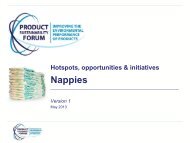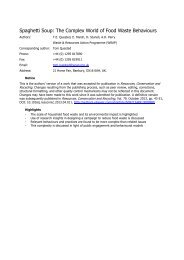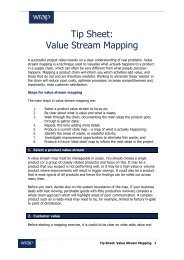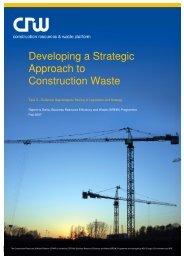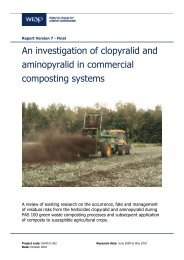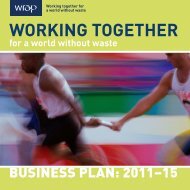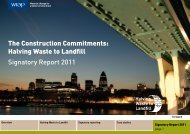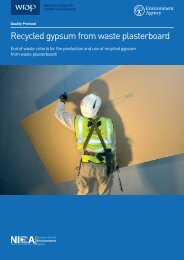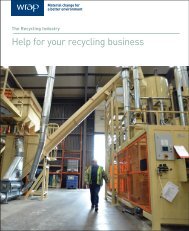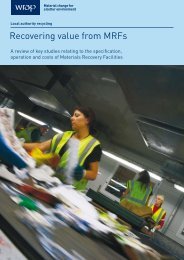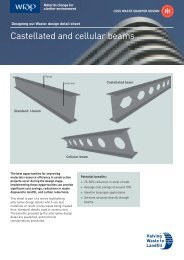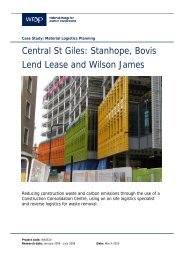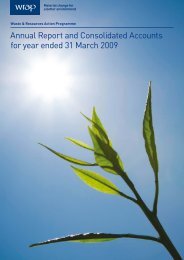Setting a requirement for Waste Minimisation and Management - Wrap
Setting a requirement for Waste Minimisation and Management - Wrap
Setting a requirement for Waste Minimisation and Management - Wrap
You also want an ePaper? Increase the reach of your titles
YUMPU automatically turns print PDFs into web optimized ePapers that Google loves.
Material change <strong>for</strong><br />
a better environment<br />
Procurement guidance <strong>for</strong> construction<br />
<strong>Setting</strong> a <strong>requirement</strong> <strong>for</strong> <strong>Waste</strong><br />
<strong>Minimisation</strong> <strong>and</strong> <strong>Management</strong>
2 <strong>Setting</strong> a <strong>requirement</strong> <strong>for</strong> <strong>Waste</strong> <strong>Minimisation</strong> <strong>and</strong> <strong>Management</strong><br />
<strong>Setting</strong> a <strong>requirement</strong> <strong>for</strong> <strong>Waste</strong> <strong>Minimisation</strong><br />
<strong>and</strong> <strong>Management</strong><br />
This guidance sets out the business case <strong>for</strong> construction clients<br />
<strong>and</strong> developers to adopt good practice waste minimisation <strong>and</strong><br />
management on their construction projects. It explains why good<br />
practice waste minimisation <strong>and</strong> management is important, how it<br />
is delivered <strong>and</strong> the crucial role that clients can play in its delivery.<br />
Why take action?<br />
■ Reduce the cost of materials supplied <strong>and</strong> associated waste disposal.<br />
■ Increase competitive advantage through differentiation.<br />
■ Improve per<strong>for</strong>mance against CSR objectives.<br />
■ Lower CO 2 emissions.<br />
■ Meet planning <strong>requirement</strong>s.<br />
■ Complement other aspects of sustainable design.<br />
■ Respond to <strong>and</strong> pre-empt changes in public policy, such as<br />
increases in L<strong>and</strong>fill Tax.<br />
Who is taking action?<br />
Construction clients, developers, policy-makers <strong>and</strong> planning<br />
authorities are increasingly asking design teams <strong>and</strong> contractors to<br />
implement good practice in waste minimisation <strong>and</strong> management.<br />
Major organisations at the <strong>for</strong>efront of the initiative include:<br />
■ property developers such as British L<strong>and</strong>, Hammerson<br />
<strong>and</strong> Stanhope;<br />
■ members of the Major Contractors Group such as Bovis Lend<br />
Lease, Skanska <strong>and</strong> Wates; <strong>and</strong><br />
■ national Governments proposing to make Site <strong>Waste</strong> <strong>Management</strong><br />
Plans m<strong>and</strong>atory.<br />
What is good practice?<br />
<strong>Waste</strong> minimisation <strong>and</strong> management follows the principles of the<br />
waste hierarchy: reduce the quantity of waste generated, then<br />
maximise the amount that can be reused or recycled. Good practice<br />
involves going beyond the current baseline per<strong>for</strong>mance of the<br />
construction industry, which has historically focused on meeting its<br />
legal obligations only.<br />
<strong>Waste</strong> minimisation includes a range of methods to ‘design-out’<br />
waste from a project <strong>and</strong> limit waste arisings during the construction<br />
phase. Examples include:<br />
■ efficient design solutions;<br />
■ improved materials logistics <strong>and</strong> storage;<br />
■ off site construction; <strong>and</strong><br />
■ minimising over-ordering.<br />
Using a single skip <strong>for</strong> all waste types is a missed<br />
opportunity to implement good practice<br />
The emphasis<br />
should be on<br />
the contractor<br />
to develop the<br />
targets <strong>for</strong><br />
waste reduction<br />
<strong>and</strong> recovery
3 <strong>Setting</strong> a <strong>requirement</strong> <strong>for</strong> <strong>Waste</strong> <strong>Minimisation</strong> <strong>and</strong> <strong>Management</strong><br />
Case study<br />
Langley Park, Beckenham<br />
A large development by Laing Homes is<br />
an example of how cost savings can be<br />
achieved through segregating waste<br />
streams <strong>and</strong> reusing materials.<br />
Measures on this development included:<br />
■ waste streams separated <strong>for</strong> easier<br />
reuse <strong>and</strong> recovery;<br />
■ reuse of materials from demolition;<br />
<strong>and</strong><br />
■ efficient storage of reusable<br />
products, e.g. timber pallets<br />
returned <strong>for</strong> reuse.<br />
The resulting savings included:<br />
■ recovery of 500,000 roofing tiles<br />
from demolished buildings <strong>for</strong> reuse;<br />
■ reuse of 40,000 tonnes of demolition<br />
spoil as sub-base; <strong>and</strong><br />
■ total cost savings of £525,000 –<br />
3.5% of project costs.<br />
The benefits of implementing a SWMP<br />
have been found to be:<br />
15% less waste onsite;<br />
43% less waste to l<strong>and</strong>fill;<br />
50% savings in waste h<strong>and</strong>ling<br />
charges; <strong>and</strong><br />
40% saving on waste management costs<br />
compared to l<strong>and</strong>fill disposal.<br />
(source: Report C536 from CIRIA)<br />
<strong>Waste</strong> management involves identifying potential waste streams,<br />
setting target recovery rates <strong>and</strong> managing the process to ensure that<br />
these targets are met. To assist the process of setting targets, WRAP<br />
has identified good practice recovery rates <strong>for</strong> a range of waste<br />
streams. On any project, there are certain key waste streams that can<br />
offer significant savings, otherwise known as ‘Quick Wins’. By<br />
implementing good practice <strong>for</strong> three to four of these ‘Quick Wins’,<br />
there is potential to increase overall recycling rates of construction<br />
waste from st<strong>and</strong>ard industry per<strong>for</strong>mance by more than 20%.<br />
<strong>Waste</strong> streams that commonly offer Quick Wins across a range of<br />
projects include:<br />
■ timber;<br />
■ plasterboard;<br />
■ packaging;<br />
■ concrete;<br />
■ inert material; <strong>and</strong><br />
■ plastics.<br />
Projects vary of course, <strong>and</strong> individual projects will need to evaluate<br />
their own waste streams to identify potential Quick Wins.<br />
Will it increase cost?<br />
No – <strong>for</strong> the majority of projects, achieving good practice will either<br />
be cost neutral or will generate cost savings. Only a minor change in<br />
working practices will be required.<br />
How is good practice delivered?<br />
The key tool <strong>for</strong> minimising <strong>and</strong> managing waste on a project<br />
is the Site <strong>Waste</strong> <strong>Management</strong> Plan (SWMP). The SWMP<br />
is not just an on site management tool. It should be<br />
initiated at an early stage of the project <strong>and</strong> used to:<br />
■ steer the design to minimise waste; <strong>and</strong><br />
■ optimise plans <strong>for</strong> onsite practice.<br />
The SWMP is used to identify potential waste<br />
streams <strong>and</strong> set waste reduction <strong>and</strong> recovery<br />
targets. Subsequently the contractor will measure<br />
actual waste produced <strong>and</strong> monitor per<strong>for</strong>mance.<br />
This will allow them to demonstrate their<br />
achievements to clients <strong>and</strong> save more on<br />
future projects.
4 <strong>Setting</strong> a <strong>requirement</strong> <strong>for</strong> <strong>Waste</strong> <strong>Minimisation</strong> <strong>and</strong> <strong>Management</strong><br />
Onsite waste minimisation techniques, <strong>for</strong> example, ‘leaner’ ordering<br />
of materials <strong>and</strong> better site storage to prevent material damage,<br />
should be incorporated into the SWMP as well as strategies <strong>for</strong><br />
segregating <strong>and</strong> reusing waste materials. This can result in less<br />
waste produced on site, <strong>and</strong> so less waste sent to l<strong>and</strong>fill, there<strong>for</strong>e<br />
savings in waste h<strong>and</strong>ling, disposal <strong>and</strong> l<strong>and</strong>fill costs.<br />
The use of a SWMP is currently a voluntary undertaking on<br />
construction projects. However, it is expected that the use of SWMPs<br />
will become a m<strong>and</strong>atory <strong>requirement</strong> in the near future <strong>for</strong> many<br />
projects throughout the UK. By making it an immediate <strong>requirement</strong><br />
<strong>for</strong> all projects to implement a SWMP to good practice levels in<br />
accordance with WRAP guidance, clients can minimise the potential<br />
impact of the regulatory change <strong>and</strong> take advantage of the benefits at<br />
an earlier date.<br />
Which projects are suitable?<br />
Good practice can be applied to all types of construction project,<br />
irrespective of location or complexity, including new build,<br />
refurbishment <strong>and</strong> infrastructure works. The benefits are expected<br />
to outweigh the costs of implementing an SWMP <strong>for</strong> projects over<br />
£250,000 in value.<br />
One practical application of good practice waste<br />
management can be to use wheeled bins at the<br />
work area<br />
<strong>Waste</strong> hierarchy<br />
The key tool <strong>for</strong><br />
minimising <strong>and</strong><br />
managing waste<br />
on a project is<br />
the Site <strong>Waste</strong><br />
<strong>Management</strong><br />
Plan<br />
<strong>Waste</strong><br />
Reduction<br />
Reuse<br />
Recycling <strong>and</strong><br />
composting<br />
Energy recovery<br />
with heat <strong>and</strong> power<br />
L<strong>and</strong>fill with energy<br />
L<strong>and</strong>fill
5 <strong>Setting</strong> a <strong>requirement</strong> <strong>for</strong> <strong>Waste</strong> <strong>Minimisation</strong> <strong>and</strong> <strong>Management</strong><br />
What do clients <strong>and</strong> developers need to do?<br />
To obtain the most benefit, adopt good practice at the earliest<br />
possible stage, preferably with a clear m<strong>and</strong>ate from the client<br />
through procurement <strong>requirement</strong>s. The targeted elements of good<br />
practice (Quick Wins) should then be communicated <strong>and</strong> implemented<br />
by the design team, contractor, sub-contractors <strong>and</strong> waste<br />
management contractors through all project phases – from outline<br />
design to project completion. The process is illustrated below:<br />
Client Design team Contractor <strong>and</strong> sub-contractors<br />
1. Set project<br />
<strong>requirement</strong><br />
<strong>for</strong> good<br />
practice WMM<br />
2. Identify key opportunities<br />
<strong>for</strong> waste minimisation<br />
Pre-design<br />
Design &<br />
procurement<br />
3. Plan waste management<br />
by developing a SWMP<br />
4. Tender <strong>and</strong> contractual<br />
<strong>requirement</strong>s <strong>for</strong> good<br />
practice SWMP<br />
implementation <strong>and</strong><br />
targeting of Quick Wins<br />
5. Set targets<br />
<strong>and</strong> Key<br />
Per<strong>for</strong>mance<br />
Indicators<br />
6. Define<br />
responsibilities<br />
<strong>and</strong> contracts<br />
7. Identify waste<br />
arisings, reuse<br />
<strong>and</strong> recycling<br />
routes<br />
8. Site design<br />
<strong>and</strong> training<br />
Pre-construction<br />
Report<br />
outcomes <strong>and</strong><br />
Quick Wins<br />
9. Monitor<br />
waste<br />
management<br />
Construction<br />
Report<br />
outcomes <strong>and</strong><br />
Quick Wins<br />
10. Review<br />
per<strong>for</strong>mance<br />
of the SWMP<br />
<strong>and</strong> lessons<br />
learnt<br />
Postconstruction<br />
Disclaimer<br />
This report has been published in good faith by WRAP with the help of Cyril Sweett, <strong>and</strong> neither WRAP nor Cyril Sweett shall incur any liability <strong>for</strong> any<br />
action or omission arising out of any reliance being placed on the report by any organisation or other person. Any organisation or other person in receipt<br />
of this report should take their own legal, financial <strong>and</strong> other relevant professional advice when considering what action (if any) to take in respect of any<br />
initiative, proposal, or other involvement with any procurement process, or be<strong>for</strong>e placing any reliance on anything contained therein. By receiving the<br />
report <strong>and</strong> acting on it, any party relying on it accepts that no individual is personally liable in contract, tort or breach of statutory duty (including negligence).<br />
While steps have been taken to ensure its accuracy, WRAP cannot accept responsibility or be held liable to any person <strong>for</strong> any loss or damage arising out<br />
of or in connection with the in<strong>for</strong>mation in this report being inaccurate, incomplete or misleading. The listing or featuring of a particular product or<br />
organisation does not constitute an endorsement by WRAP <strong>and</strong> WRAP cannot guarantee the per<strong>for</strong>mance of individual products or materials. For more<br />
detail, please refer to our Terms & Conditions on our website www.wrap.org.uk.
6 <strong>Setting</strong> a <strong>requirement</strong> <strong>for</strong> <strong>Waste</strong> <strong>Minimisation</strong> <strong>and</strong> <strong>Management</strong><br />
What are the next steps?<br />
See the other documents in this suite, Achieving good practice waste minimisation <strong>and</strong><br />
management <strong>and</strong> Delivering good practice waste management.<br />
<strong>Setting</strong> a <strong>requirement</strong><br />
In order to m<strong>and</strong>ate the process of adopting good practice on a project, clients <strong>and</strong> developers<br />
can include the following core <strong>requirement</strong> in the project procurement documentation:<br />
‘….we require a Site <strong>Waste</strong> <strong>Management</strong> Plan (SWMP) to be developed from the pre-design<br />
stage to in<strong>for</strong>m the adoption of good practice waste minimisation in design, <strong>and</strong> <strong>for</strong> the SWMP to<br />
be implemented in all construction site activities in line with good practice published by WRAP.<br />
The SWMP is required to set targets <strong>for</strong> waste reduction <strong>and</strong> recovery based on an assessment<br />
of the likely composition <strong>and</strong> quantity of waste arisings <strong>and</strong> identification of the most significant<br />
cost-effective options <strong>for</strong> improvement (Quick Wins). This should be supplemented by<br />
in<strong>for</strong>mation on how the targets will be achieved during construction activities <strong>and</strong> how the actual<br />
levels of waste reduction <strong>and</strong> recovery will be monitored <strong>for</strong> comparison with the targets set.’<br />
The emphasis should be on the contractor to develop the targets <strong>for</strong> waste reduction <strong>and</strong><br />
recovery, in conjunction with the design team, after identifying which waste streams to focus on<br />
<strong>and</strong> the appropriate methods to adopt. This is because the contractor is best placed to identify<br />
opportunities <strong>for</strong> improved per<strong>for</strong>mance <strong>and</strong> cost saving, given their position at the interface<br />
between the design <strong>and</strong> construction phases of the project, taking into account the supply chain<br />
to be employed.<br />
Guidance <strong>for</strong> design teams <strong>and</strong> contractors<br />
To enable design teams to develop a detailed response to the client’s <strong>requirement</strong>, <strong>and</strong> to help<br />
contractors deliver good practice, WRAP have produced more detailed documents providing<br />
procedural guidance <strong>for</strong> setting <strong>requirement</strong>s, including model contract clauses, <strong>and</strong> technical<br />
guidance <strong>for</strong> practical implementation. These reference documents are freely available at<br />
www.wrap.org.uk/construction.<br />
These resources contain template wording <strong>and</strong> model contract clauses <strong>for</strong> use in corporate policy<br />
statements, project briefs <strong>and</strong> prequalification processes, <strong>and</strong> subsequently in tender, appointment<br />
<strong>and</strong> contractual processes <strong>for</strong> traditional <strong>and</strong> design <strong>and</strong> build procurement processes.<br />
Further in<strong>for</strong>mation<br />
WRAP provides guidance <strong>and</strong> tools covering all aspects of materials efficiency in construction,<br />
including waste reduction, recycling <strong>and</strong> recycled content. These are freely available at<br />
www.wrap.org.uk/construction.<br />
Published by: The Old Academy Tel: 01295 819 900 Helpline freephone<br />
<strong>Waste</strong> & Resources 21 Horse Fair Fax: 01295 819 911 0808 100 2040<br />
Action Programme Banbury, Oxon E-mail: info@wrap.org.uk<br />
OX16 0AH<br />
www.wrap.org.uk/construction<br />
Printed on 75% recycled<br />
content paper



